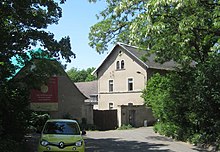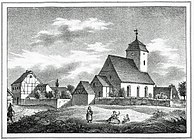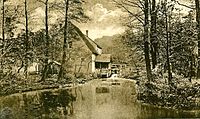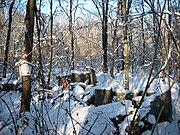Portitz

Portitz is a district in the northeast of Leipzig . From 1838 to 1935 it was an independent municipality that was incorporated into Leipzig on May 15, 1935. Since the incorporation of the neighboring Plaussig into Leipzig in 1996 , Portitz together with the latter forms the Leipzig district of Plaußig-Portitz .
Location and local characteristics
Portitz is about eight kilometers from Leipzig city center. Its neighbors to the east are the city of Taucha and, further clockwise, the Leipzig districts of Paunsdorf , Thekla and Plaußig . The old town center of Portitz is located on the southern (“left”) bank of the Parthe between the Taucha district of Graßdorf in the east and the former village of Cleuden, which now belongs to Thekla, in the west. The old village center of Plaußig is on the opposite bank of the Parthe.
While the Portitzer village center has its rural character with three or more listed buildings. Vierseithöfen, although hardly any agriculture is still practiced, a large settlement area with single-family houses extends to the southeast, the settlement parts of which were built between 1928 and 1940: Lehm- and Schwarzsiedlung (1928), Portitzer Winkel (1930–1940), Grenzsiedlung (1930) , Randsiedlung (1931), Moränensiedlung (1934–1938), Krätzbergsiedlung (1938/39), Teichsiedlung (1939/40) and the Ackermannsiedlung (1938–40). This gives Portitz for the most part the character of a garden city .
The settlements are located on both sides of the town's main street, Tauchaer Straße, which is almost two kilometers long in the Portitzer area and connects to Taucha and the inner areas of Leipzig. Portitz is connected to the Leipzig public transport network via bus routes 81 and 82 from Thekla ; Line 81 goes to Taucha. For long-distance traffic, the Leipzig-Nordost junction of Autobahn 14 can be reached in one to two kilometers.
Around the Parthe, which roughly represents the Portitz border in the north, flows through meadows and the remains of what was originally a larger alluvial forest . At the old center of the village, the terrain drops quite steeply to the Parthe by about seven meters. The Portitzer Church is also on this hill.
history
The village of Portitz was probably created by West Slavic (Sorbian) settlers in the 7th century. While the ending “-itz” is typical for Slavic villages, the root word “p [a / o] rt-” could refer to the Parthe; the first mention of the place as Borintizi is usually interpreted as "a village of a Borin (a)". The first mention in 974 by Thietmar von Merseburg is one of the first in the Leipzig area.
After the beginning of the German expansion to the east, German settlers probably settled here around the year 1000. The result was a manor house mentioned in 1350, which only became a manor for a short time, after which the manor was at the manor Graßdorf or temporarily with the Leipzig council when Graßdorf had bought it.
The Graßdorfer Church had a large Madonna figure from the 14th century, which established a lively pilgrimage activity, from whose income the church could be renewed after the Reformation in 1602. This was replaced by the current one in 1865–1867, although the tower had to be shortened in 1969/1970 due to its dilapidation. In 1823 a water mill was built on the Parthe, which was in operation until 1904.
In 1835 the village comprised 15½ Magazinhufen land, 26 houses and 169 residents. With the Saxon rural community order of 1838 , the village of Portitz became a rural community and received the right to self-government.
Landlords of Portitz were initially the Margraves of Meißen or Landsberg and the Electors of Saxony (1423–1485), then the Albertine Dukes of Saxony (1485–1547) and the Electors of Saxony (1547–1806) as well as the Kings of Saxony ( 1806-1890). Within the Saxon state, the village of Portitz belonged to the Leipzig district office and from 1873 to 1935 to the Leipzig district administration . On May 15, 1935, the Portitz community was incorporated into the city of Leipzig. With the municipal reorganization of Leipzig in 1992, the former municipal area became the district of Portitz, which was expanded in 1995 to become the district of Plaußig-Portitz.
From 1935 industrial plants of the Central German Motor Works (MMW) were built in the north-eastern part of the Portitzer Flur, in the Portitzer wood . Up to 10,000 employees (including forced laborers ) manufactured aircraft engines for Junkers aircraft and engine plants here. On April 1, 1939, the site was moved around to Taucha. Bomb attacks severely damaged the plant in 1944. From 1946 to 1947 the factory facilities were dismantled and the buildings blown up.
In the corner between Tauchaer Strasse and the motorway, the Portitz-Treff supply center was built in 1993 with extensive retail and a hotel. In 1997 the development of the new residential area Parkstadt 2000 followed on an area of 65 hectares east of it , but most of it is still undeveloped.
literature
- Portitz - A Historical and Urban Study . PRO LEIPZIG 2001
- Vera Danzer, Andreas Dix: Leipzig - A regional history inventory in the Leipzig area . Ed .: Haik Thomas Porada . 1st edition. Böhlau, Cologne Weimar Vienna 2015, ISBN 978-3-412-22299-4 , pp. 260-262 .
- Horst Riedel, Thomas Nabert (ed.): Stadtlexikon Leipzig from A to Z . 1st edition. Pro Leipzig, Leipzig 2005, ISBN 3-936508-03-8 , pp. 469-470 .
- Portitz . In: August Schumann : Complete State, Post and Newspaper Lexicon of Saxony. 8th volume. Schumann, Zwickau 1821, p. 519.
- Cornelius Gurlitt : Portitz. In: Descriptive representation of the older architectural and art monuments of the Kingdom of Saxony. 16. Issue: Amtshauptmannschaft Leipzig (Leipzig Land) . CC Meinhold, Dresden 1894, p. 106.
Web links
- Portitz. In: Leipzig Lexicon. Retrieved January 11, 2020 .
- Portitz in the Digital Historical Directory of Saxony
Individual evidence
- ↑ a b Vera Danzer, Andreas Dix: Leipzig - A regional history inventory in the Leipzig area . Ed .: Haik Thomas Porada . 1st edition. Böhlau, Cologne Weimar Vienna 2015, ISBN 978-3-412-22299-4 , pp. 260-262 .
- ^ Karlheinz Blaschke , Uwe Ulrich Jäschke : Kursächsischer Ämteratlas. Leipzig 2009, ISBN 978-3-937386-14-0 , pp. 60 f.
Coordinates: 51 ° 23 ′ 11 ″ N , 12 ° 27 ′ 5 ″ E




